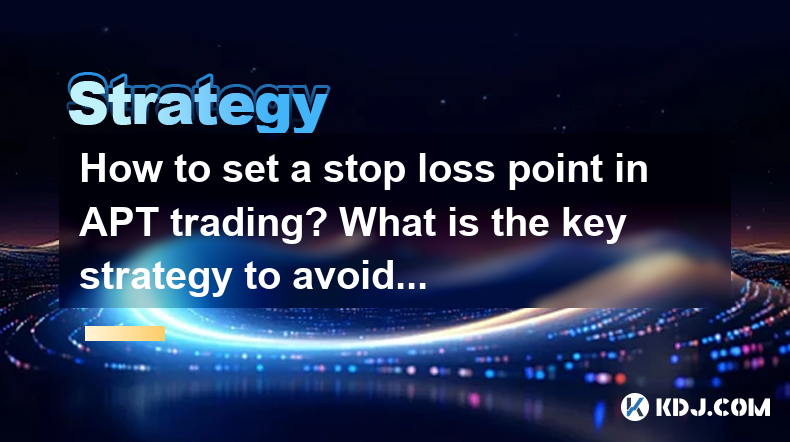-
 bitcoin
bitcoin $122659.385674 USD
0.52% -
 ethereum
ethereum $4484.113342 USD
-0.09% -
 bnb
bnb $1304.229256 USD
-0.85% -
 tether
tether $1.000204 USD
-0.03% -
 xrp
xrp $2.860636 USD
-0.51% -
 solana
solana $227.288799 USD
2.36% -
 usd-coin
usd-coin $0.999805 USD
0.01% -
 dogecoin
dogecoin $0.252837 USD
1.18% -
 tron
tron $0.341149 USD
1.12% -
 cardano
cardano $0.830507 USD
0.33% -
 hyperliquid
hyperliquid $45.792319 USD
0.04% -
 chainlink
chainlink $22.422164 USD
1.55% -
 ethena-usde
ethena-usde $1.000283 USD
0.01% -
 sui
sui $3.511389 USD
0.83% -
 stellar
stellar $0.385276 USD
-0.44%
How to set a stop loss point in APT trading? What is the key strategy to avoid losses?
A stop loss order in APT trading limits losses by automatically selling at a set price, crucial in the volatile crypto market.
May 04, 2025 at 06:01 pm

Introduction to Stop Loss in APT Trading
Setting a stop loss point is a crucial strategy in trading cryptocurrencies like APT (Aptos). A stop loss order is designed to limit an investor's loss on a position in a security. By setting a stop loss, traders can ensure that their potential losses do not exceed a certain level. This is particularly important in the volatile cryptocurrency market, where prices can fluctuate dramatically in a short period. In this article, we will explore how to set a stop loss point in APT trading and discuss key strategies to avoid losses.
Understanding the Importance of Stop Loss
Before delving into the mechanics of setting a stop loss, it's essential to understand why it's important. A stop loss order helps traders manage risk by automatically selling a security when it reaches a certain price. This can prevent significant losses in the event of an unexpected market downturn. In the context of APT trading, where prices can be highly volatile, a stop loss can be a trader's best defense against unforeseen price drops.
How to Set a Stop Loss Point in APT Trading
Setting a stop loss point in APT trading involves several steps that traders must follow carefully. Here’s a detailed guide on how to do it:
Choose a Trading Platform: First, ensure you are using a trading platform that supports stop loss orders. Popular platforms like Binance, Coinbase, and Kraken offer this feature.
Access Your Trading Account: Log into your trading account and navigate to the APT trading section.
Select the APT Trading Pair: Choose the APT trading pair you wish to trade, such as APT/USDT or APT/BTC.
Place a Trade Order: Decide whether you want to buy or sell APT. If you're buying, you'll need to set a stop loss to limit potential losses on your long position.
Set the Stop Loss Price: Determine the price at which you want the stop loss to trigger. This should be based on your risk tolerance and the current market conditions. For example, if you buy APT at $10, you might set a stop loss at $9 to limit your loss to 10%.
Enter the Stop Loss Order: On your trading platform, enter the stop loss price in the appropriate field. Some platforms may require you to set a stop loss order separately from your initial buy order.
Review and Confirm: Double-check all the details of your order, including the stop loss price, and confirm the order. Once confirmed, the stop loss order will be active.
Key Strategies to Avoid Losses in APT Trading
While setting a stop loss is a fundamental risk management tool, there are other strategies traders can employ to minimize losses when trading APT. Here are some key strategies:
Technical Analysis: Use technical analysis to identify potential support and resistance levels. By understanding these levels, you can set more informed stop loss points. For example, if APT is approaching a strong support level, you might set your stop loss just below this level to avoid being stopped out prematurely.
Diversification: Don't put all your funds into APT. Diversify your portfolio across different cryptocurrencies and asset classes to spread risk. This way, a significant drop in APT's price won't devastate your entire portfolio.
Position Sizing: Manage the size of your positions carefully. Only invest a small percentage of your total capital in any single trade. This ensures that even if a trade goes against you, the loss will be manageable.
Stay Informed: Keep up with the latest news and developments in the cryptocurrency market. Sudden news events can cause significant price movements, so being informed can help you adjust your stop loss levels accordingly.
Use Trailing Stops: A trailing stop is a type of stop loss order that moves with the market price. If APT's price increases, the trailing stop will move up, locking in profits while still protecting against a downturn. This can be particularly useful in a trending market.
Monitoring and Adjusting Your Stop Loss
Once you've set a stop loss, it's important to monitor and adjust it as needed. Market conditions can change rapidly, and what was a suitable stop loss level yesterday might not be appropriate today. Here are some tips for monitoring and adjusting your stop loss:
Regularly Review Your Positions: Check your open positions daily or even more frequently if the market is particularly volatile. Adjust your stop loss levels based on new market data and technical indicators.
Move Your Stop Loss Up: If APT's price moves in your favor, consider moving your stop loss up to lock in some profits. This can help you secure gains while still protecting against a reversal.
Be Aware of Gaps: Cryptocurrency markets can experience gaps, where the price jumps from one level to another without trading in between. Be cautious of setting stop losses too close to the current price, as a gap could trigger your stop loss at a worse price than intended.
Use Alerts: Many trading platforms allow you to set price alerts. Use these to notify you when APT reaches certain price levels, so you can make timely adjustments to your stop loss.
Common Mistakes to Avoid When Setting Stop Losses
While stop losses are a powerful tool, they can be misused. Here are some common mistakes to avoid:
Setting Stop Losses Too Tight: If your stop loss is too close to the current price, it may be triggered by normal market fluctuations rather than a significant downturn. This can result in being stopped out of a position prematurely.
Ignoring Market Volatility: Different cryptocurrencies have different levels of volatility. Failing to account for APT's volatility when setting your stop loss can lead to unnecessary losses.
Not Adjusting Stop Losses: Once set, a stop loss should not be forgotten. Regularly review and adjust your stop loss levels to reflect current market conditions.
Over-Reliance on Stop Losses: While stop losses are important, they should not be the only risk management tool you use. Combine them with other strategies like diversification and position sizing for a more robust approach to risk management.
Frequently Asked Questions
Q: Can I set a stop loss on all trading platforms?A: Not all trading platforms support stop loss orders. It's important to check whether your chosen platform offers this feature before you start trading APT.
Q: What is the difference between a stop loss and a take profit order?A: A stop loss order is designed to limit losses by selling a security when it reaches a certain price, while a take profit order is used to lock in profits by selling when the price reaches a predetermined level.
Q: How often should I adjust my stop loss?A: The frequency of adjusting your stop loss depends on market conditions and your trading strategy. In highly volatile markets, you might need to check and adjust your stop loss daily, while in more stable conditions, weekly reviews might suffice.
Q: Can a stop loss guarantee that I won't lose more than a certain amount?A: No, a stop loss cannot guarantee a specific loss amount due to market gaps and slippage. However, it can significantly reduce the risk of large losses.
Disclaimer:info@kdj.com
The information provided is not trading advice. kdj.com does not assume any responsibility for any investments made based on the information provided in this article. Cryptocurrencies are highly volatile and it is highly recommended that you invest with caution after thorough research!
If you believe that the content used on this website infringes your copyright, please contact us immediately (info@kdj.com) and we will delete it promptly.
- Coin, 2025, Bull Run: What's the Hype?
- 2025-10-10 04:45:14
- Bluey Ballot Bonanza: Real Life Coin Tips from Down Under!
- 2025-10-10 05:05:13
- Toncoin (TON) Price Analysis: Crash or Correction? What's a New Yorker to Do?
- 2025-10-10 04:45:14
- Bluey Ballot Bonanza: Real Life Coin Tips from Down Under!
- 2025-10-10 04:50:01
- HBAR, SHIB, BlockDAG: Crypto's Fast Lane to 2025 and Beyond
- 2025-10-10 05:05:13
- Worldcoin (WLD): Navigating the Accumulation Zone Like a Pro
- 2025-10-10 05:10:00
Related knowledge

Practical parameter settings for a Bitcoin multi-timeframe moving average system
Sep 18,2025 at 10:54pm
Optimizing Timeframe Combinations for Bitcoin Trading1. Selecting appropriate timeframes is crucial when building a multi-timeframe moving average sys...

How can I filter out false breakouts in Dogecoin high-frequency trading?
Sep 22,2025 at 01:00am
Understanding False Breakouts in Dogecoin Trading1. A false breakout occurs when Dogecoin's price appears to move beyond a defined support or resistan...

Techniques for identifying tops and bottoms in the Bitcoin on-chain NVT model
Sep 20,2025 at 07:54pm
Understanding the NVT Model in Bitcoin Analysis1. The Network Value to Transactions (NVT) ratio is often described as the 'P/E ratio' of the cryptocur...

What does the surge in open interest in Bitcoincoin futures mean?
Sep 20,2025 at 11:18pm
Understanding the Surge in Dogecoin Futures Open Interest1. A surge in open interest within Dogecoin futures indicates a growing number of active cont...

How can I use the Ethereum USDT premium to gauge market sentiment?
Sep 18,2025 at 11:55pm
Understanding the Ethereum USDT Premium1. The Ethereum USDT premium refers to the price difference between USDT (Tether) traded on Ethereum-based plat...

What should I do if Ethereum staking yields decline?
Sep 20,2025 at 06:18am
Understanding the Causes Behind Declining Ethereum Staking Yields1. The Ethereum network transitioned to a proof-of-stake consensus mechanism with the...

Practical parameter settings for a Bitcoin multi-timeframe moving average system
Sep 18,2025 at 10:54pm
Optimizing Timeframe Combinations for Bitcoin Trading1. Selecting appropriate timeframes is crucial when building a multi-timeframe moving average sys...

How can I filter out false breakouts in Dogecoin high-frequency trading?
Sep 22,2025 at 01:00am
Understanding False Breakouts in Dogecoin Trading1. A false breakout occurs when Dogecoin's price appears to move beyond a defined support or resistan...

Techniques for identifying tops and bottoms in the Bitcoin on-chain NVT model
Sep 20,2025 at 07:54pm
Understanding the NVT Model in Bitcoin Analysis1. The Network Value to Transactions (NVT) ratio is often described as the 'P/E ratio' of the cryptocur...

What does the surge in open interest in Bitcoincoin futures mean?
Sep 20,2025 at 11:18pm
Understanding the Surge in Dogecoin Futures Open Interest1. A surge in open interest within Dogecoin futures indicates a growing number of active cont...

How can I use the Ethereum USDT premium to gauge market sentiment?
Sep 18,2025 at 11:55pm
Understanding the Ethereum USDT Premium1. The Ethereum USDT premium refers to the price difference between USDT (Tether) traded on Ethereum-based plat...

What should I do if Ethereum staking yields decline?
Sep 20,2025 at 06:18am
Understanding the Causes Behind Declining Ethereum Staking Yields1. The Ethereum network transitioned to a proof-of-stake consensus mechanism with the...
See all articles


























![🚨IS VECHAIN (VET) A DEAD COIN ?? PRICE ANALYSIS [GET READY NOW] 🚨IS VECHAIN (VET) A DEAD COIN ?? PRICE ANALYSIS [GET READY NOW]](/uploads/2025/10/09/cryptocurrencies-news/videos/vechain-vet-dead-coin-price-analysis-ready/68e7b200b067b_image_500_375.webp)















































